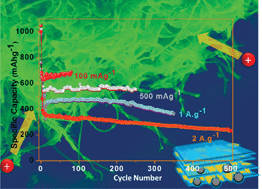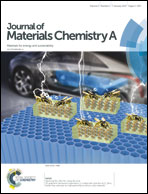Exfoliated MoS2 nanosheets confined in 3-D hierarchical carbon nanotube@graphene architecture with superior sodium-ion storage†
Abstract
Sodium-ion batteries (SIBs) have undergone extensive research efforts as compatible successors of Li-ion batteries (LIBs) for grid-scale energy storage owing to the abundance of sodium resources. However, the poor cycling stability and low rate capability of existing anodes has prevented the practical application of SIBs. To mitigate the situation we have created a 3D heterostructure electrode based on alternative layers of 2D (MoS2–graphene) and 1D (CNTs) materials via a hydrothermal route that is fundamentally different from the usual composites. For comparison, composites were prepared using the same experimental conditions with either rGO or MWCNTs. While discharging at 100 mA g−1 and 500 mA g−1, the MoS2–MWCNT@rGO could deliver a high discharge capacity of 664 mA h g−1 and 551 mA h g−1, and retained 100% and 98.4% capacity after 80 and 250 discharge–charge cycles, respectively. At 2 A g−1, it can yield an initial discharge capacity of 375 mA h g−1, maintaining 81.3% and 67% capacity after 250 and 500 cycles, respectively. The excellent performance of the MoS2–MWCNT@rGO hybrid is mainly attributed to the robust MWCNT@rGO framework with improved 3D electrical conductivity, additional porosity and excellent buffering capability. Furthermore, an in situ TEM technique was employed to explore the sodiation mechanism of the MoS2 nanosheets.


 Please wait while we load your content...
Please wait while we load your content...